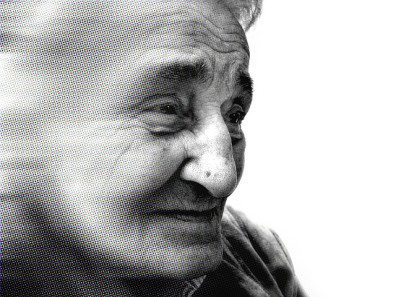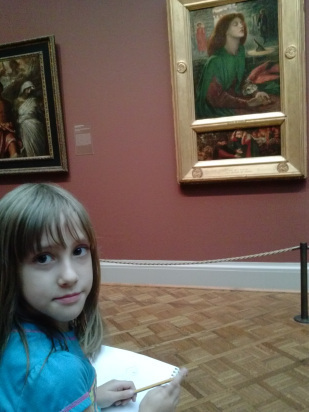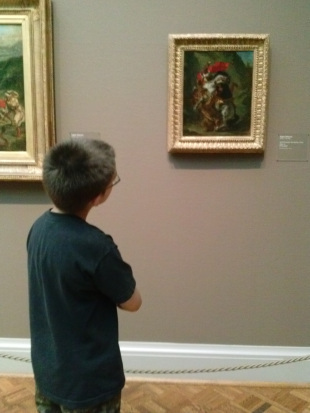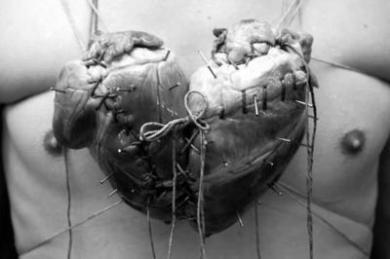Eileen Maksym's Blog, page 26
June 16, 2014
Life and death behind perfect doors
When my family was living in Evanston, IL, our apartment was on the outskirts of a neighborhood of beautiful historic homes. Walking to the beach, to the university, to one of four nearby playgrounds, would take us past these gorgeous, multi-million dollar houses. It was strange, living in such close proximity to these homes that we will never be able to afford (I’m an author, my husband is an astrophysicist, I harbor no delusions about our chances of ever becoming rich). With a couple notable exceptions (one being a hulking brick structure buried in ivy, with peeling white columns and dark shuttered windows) the homes were meticulously cared for, beautifully detailed with finely maintained lawns and gardens of flowers and even the occasional vegetables, tomatoes and cucumbers and snap peas. Perfect.
All the more shocking when I found out about the bodies.
One of the houses that we’d pass by while taking the kids to the park belonged to a 90 year old woman. I believe we saw her once or twice, out in the yard, tending her plants. When her name hit the papers, her neighbors said the things that neighbors always say in such instances. She was sweet and friendly, liked to give away cuttings from her plants. Entirely normal. There were no indications that anything was wrong. And when they didn’t see her for a couple days, the neighbors got worried, and called the police to check in on her. They found her inside, weak and malnourished and dehydrated.
And they found the bodies of her brother and two sisters.
They died of natural causes, the police said. Time of death was unclear, but according to neighbors, the brother had last been seen earlier that year. One of the sisters had last been seen five years before. And the other sister? Last seen in the 1980′s.
I can only imagine what it must have been like for these siblings. None of them ever married, and after their parents died, all they had was each other. When the one sister died in the eighties, was there a fight among the remaining three? Did one sibling want to report the death, bury their sister properly, and was talked down by the other two? Or was there a silent agreement that they must stay together, no matter what, even in death?
What was it like, having their sister lying dead in one of the rooms of the house. Did they visit her every day, washing her body, washing her hair, caring for her in death as they had in life? Or did they close the door, go about life as if her corpse wasn’t there, even when the stench of decay was overpowering?
When the other sister died, they had already had the body of the first sister in the house for fifteen years, so keeping the body of the second must have been a matter of course. And when her brother died, what was the remaining sibling to do but keep them together as the last bastion of the family? Did she object when the police came in to take her away, to take the bodies of her brother and sisters away? Did she want to die in that house, her brother and sisters close, like they had died? Did it feel like a defeat when she could not defend their unity, keep them from being broken up at last? She had been living that way for over two decades. Whether by conviction or inertia, she had chosen that way of living. Having it wrested from her much have been a terrible blow. I do not know what happened to her after she was “rescued,” but somehow I doubt she lasted long, being alone for the first time in her life.
The house was surrounded in yellow police tape for a week. When it was taken down, it was hard to remember which house it had been. It was just one beautiful house in a neighborhood of beautiful houses. A perfect exterior that hid the rottenness inside.

June 13, 2014
Moonlight Sonata in the Key of G(ravity)
When I was a sophomore at Yale, I lived in a three story apartment building across from my residential college that was owned by the school for the purpose of overflow housing. The drawbacks of not living in the same space as the rest of my classmates were more than made up for by the fact that the apartment had a kitchen. And cable TV (which the dorms did not have at the time. God how things have changed). And a bathroom. With a shower that wasn’t a stall used daily by a dozen people. And a bathtub.
It was awesome.
One night I was up late working on a paper (on The Cherry Orchard by Chekhov) when I heard a strange sound from the hallway: hushed excited voices and half-suppressed giggles along with a heavy scraping sound. The best I could figure was that somebody had decided to get a bunch of friends together to help them move furniture. At 2 a.m.. Weird, but hey, it was college. College kids do lots of things in the very, very wee hours of the morning. And we were on the top floor of the building, so any furniture moving would require a lot of help. The sound went past my door and faded down the hall, and I shook my head and went back to my paper.
Then I heard unhushed voices and giggling from outside. My first thought was that the party had moved onto one of the fire escapes. But there was something odd about the sounds that I couldn’t place. Curiosity got the best of me, and I went into the bedroom to take a look out that window.
Now, the building was configured in a U shape. The front facade was the bottom of the U, while the open top faced the back. The inside of the U was part of the parking lot, but since keeping a car in New Haven is a pain in the neck, butt, and all other parts of the body, very few students have vehicles, so the parking lot was almost always empty, as it was that night. My bedroom window was on the right hand side of the U, which meant I had a perfect view of the bottom of the U, where the fire escapes were.
I left the bedroom light off, and when I got to the window, I checked out the fire escapes. They were empty, and I frowned, confused. Then I heard the sound again, a burst of furtive giggles, and realized that the voices were coming from the roof of the side of the U directly across the parking lot from where I was. There was a cluster of people up there, maybe seven or so, and they were talking and laughing and peering over the edge of the roof at the three story drop.
Then there was that heavy scraping sound.
And they pushed a piano up to the ledge.
My eyes went wide.
“One!” they cheered.
No!
“Two!”
They wouldn’t!
“Three!!!”
And in a surge of motion, they pushed the piano over the ledge.
There was a moment, one silent, crystal clear and surreal moment, where the piano fell through space, weightlessly graceful.
A concussive CRASHSPROING!!! Wood and wire and metal SMASHED to bits on asphalt!
The vandals cheered!
I stared at the annihilated instrument in disbelief. When I looked back up at the roof, the crowd had vanished.
Stunned, I went back to my desk. Went back to writing about Chekhov’s work, with the image of a falling piano in the back of my mind. In the morning I would go out to the parking lot to see in daylight the hulking corpse, long splinters of wood and coils of wire thrust to the sky. But for the night my mind was caught up in it all, in the impossibility, and the inevitability, of watching a piano fall.

June 11, 2014
BEST. POST. EVER!!!
I get really excited about stuff.
I’ve always been this way. Whatever I like at any particular time, I will go all in with my enthusiasm, declare that this song, this book, this movie, this cappuccino, this chocolate chip cookie, is OMG THE BEST EVER!!!!!!!!!! I will go full fangirl at the drop of a hat if you mention something I’m really really into right now. Elementary? OMG BEST EVER!!! Mirrors by Justin Timberlake? OMG BEST EVER!!! The Dresden Files by Jim Butcher? OMG BEST EVER!!!
It doesn’t mean I can’t recognize and discuss the flaws in the things I’m fangirling over. I will, for instance, happily discuss at length the problems in season two of Elementary. They are legion. And yet when I have the opportunity to watch an episode, I squee and do the Kermit YAY!!! flail. Because it is OMG THE BEST EVER!!!
Living in superlatives has its downsides, of course. Obviously, if Tyrion Lannister dies, or Elementary is cancelled (or, worse, jumps the shark), I will be crushed in a way I would avoid if I didn’t throw myself into it so completely. More problematic, though, is that getting this excited over everything echoes mania. I’m bipolar, and before finding the right combination of mood stabilizers and antidepressants, I would have periods where everything was BRIGHT and WONDERFUL and WOW and OMG THE BEST EVER!!! Where I was bouncy and excited and talked fast and had ALL THE ANSWERS!!! Periods that were inevitably followed by a hard crash.
I haven’t had one of those episodes in years, but getting superlatively excited can sometimes give me pause. Sometimes I’m hyper aware of my moods, and worry that fangirling over something is me ascending the first hill of the emotional rollercoaster that is bipolar disorder.
In spite of the downsides, though, I like the way I am. I like being unreservedly excited about things. I like loving things with abandon. I like squeeing and flailing and fangirling. I like getting other people excited about the things I’m excited about. And I wouldn’t trade all that for anything.

June 9, 2014
At Chicago’s Art Institute
Fair warning: I’m going to brag about my kids.
We spent the last week in Chicago (hence my radio silence) so that my husband Pete could spend time with his ailing father and work through some of his legal issues. While he was dealing with all that, I took the kids on outings around the city. On Monday we went to Chicago’s famed Art Institute. I love the museum. We’d been there a number of times while we were living in Chicago. We visited when the kids were little and I was still pushing Josie around in a stroller and taking breaks to breastfeed while Pete did his best to wrangle a three year old Kolbe. The kids and I went during the summer before our move to Alabama, when Pete was spending all his time working on finishing his dissertation. And Pete and I have made the Art Institute a part of our anniversary celebration on two occasions, once in conjunction with the awesome Taste of Chicago, and once as part of our 10th anniversary, which included time at the museum along with high tea at the nearby Russian Tea House, a trip to the top of the Sears Tower (Willis who?) and an amazing fondue dinner at Geja’s.
I didn’t know what to expect from the kids on this visit. The last time they visited the museum was two years ago, when Josie was five and Kolbe seven. They were fairly well behaved, but very impatient, and not really interested in the art. This time we had a little over four hours to fill, and I was worried that they would only be able to take two before they were bored out of their skulls and letting me (and everyone in our proximity) know it.
What actually happened makes me so proud of my kids.
We started in the Renaissance, and from the very beginning both kids were deeply interested. We went painting by painting, and I pointed out symbolism, told them the bible stories depicted (when applicable), and did my best to talk art theory. (At one point I was using a painting of the ruins of a Greek temple to explain perspective, and a woman came up to tell me she was impressed that I was teaching perspective to kids so young.) Kolbe and Josie excitedly pointed out paintings and objects that they liked, and wherever there was a bench, my daughter asked if we could stop and draw in the sketchbooks I had brought for them. Kolbe wasn’t as interested in drawing, but he was willing to sit quietly and look at the art while Josie and I sketched our favorite pieces. I am very rusty at drawing; I used to draw a lot in college, but haven’t really put pencil to paper at all in the past five or so years. Sketching alongside my daughter was amazing, and I’m in awe of her talent.
When we got around to the Impressionists, we talked about Van Gogh’s brush strokes, Degas’ ballerinas, Seurat’s pointillism, Monet’s landscapes in different light, Rodin’s sculptures with the mold seams left in place. Kolbe and Josie were attentive and eager to make observations, about how Van Gogh’s brushstrokes made the scenes look like they were moving, or how one of Monet’s haystacks must have been at sunrise while the other was at sunset (supposedly it was the other way around).
I had been afraid that the kids wouldn’t last the entire four plus hours, but as closing time grew near, we unfortunately had to rush through the American contemporary collection, with Nighthawks and American Gothic, and we didn’t get to the modern wing at all. It is definitely worth another trip the next time we’re in Chicago (which looks like it may be sooner rather than later, as Pete’s dad’s condition is rapidly declining).
Admission to the Art Institute is $23 for adults, but free for children. Appropriate, since Kolbe and Josie’s experience was priceless.

May 28, 2014
A lie is halfway around the world before the truth can get its boots on
The picture above has been floating around the internet for some time now. I first encountered it on Tumblr, where someone added a comment that the heart shape, our symbol for love, actually came from two hearts sewn together. People reblogged that explanation like mad, and now it’s all over the internet.
Totally romantic, right? Also totally B.S. The origin of the heart symbol is unclear, but historians speculate, among other things, that it comes from the shape of the seed of the silphium plant, once used as contraception, or even a representation of a woman’s buttocks and vagina. Two hearts sewn together is a complete fiction, but like so many things, a lie becomes stronger than the truth when it is attractive (“sexy,” as we say in philosophy) and repeated over and over.
It’s fascinating (and disturbing!) how prevalent this sort of thing is. Our knowledge of the past is marred by misconceptions, fiction taken as fact, and outright lies. Viking helmets didn’t actually have horns. Napoleon wasn’t short. Catherine the Great didn’t have a sexual predilection for horses. Paul is not dead, the walrus is not a symbol of death in Eskimo culture, “glass onion” is not a slang term for a coffin. And you do not swallow eight spiders in your sleep every year (that “fact” was actually created as an example of how ridiculous things travel around the internet as truth. Point made.)
There’s an Elementary episode from season one where Sherlock reveals that one of his hobbies is conspiracy theorists. “I love them,” he explains to Joan. “Like one loves a barmy uncle. Or a pet that walks into walls.” He joins conspiracy theory websites and periodically stirs the pot with a theory that he has constructed out of whole cloth. The CIA invented crack. The Supreme Court is owned by Scientologists.
I have at times toyed with the idea of doing something similar: creating a Tumblr account purely for the purpose of disseminating “facts,” and watching which ones take off and which ones don’t. It would be an interesting experiment, but I do have moral qualms about deliberately misleading people, even if it’s something as innocuous as the heart symbol being based on two hearts sewn together.

May 23, 2014
Just For Now
I love Imogen Heap, and how she spins music from nothing more than her voice and her claps. I’d love to learn how to do it.

May 21, 2014
The Band Always Wins
I was in the Yale Precision Marching Band (YPMB for short) when I was an undergrad. I was one of the Squids: basically an auxiliary, but a hundred times more awesome. We create props, perform in the halftime shows, and dance in the stands. And blow things up. Can’t forget that. (The origin of the name Squids is somewhat contested, but the predominant story is that once upon a time somebody called the auxiliary the “Tactical Death Squad,” which someone misheard as “Tactical Death Squids.” We have had ten tentacles ever since.)
Yale’s major rival is Harvard. (We have a saying: “Harvard sucks, Princeton doesn’t matter.” Which is sort of sad for Princeton, since they think Yale is their rival!) The biggest football game of the year is the Yale/Harvard game (also known as The Game), the last game of the season, played the Saturday before Thanksgiving. The Squids pull out all the stops and design a halftime show centered on an Uber Prop. One year it was a fire-breathing dragon. Another year it was a shark that actually ate people.
And then, of course, there are the pranks. The video above is my favorite. Enjoy!

May 19, 2014
Wonderwall
Wonderwall will always remind me of my first time in Paris as a senior in high school. Of sitting on the steps of Montmartre and listening to a busker play the song on a guitar while passersby tossed francs into his open case. This acapella version takes that memory and adds a light gossamer layer of mystery while drawing the focus back to the words with that hauntingly high and clear voice. Maybe you’re gonna be the one that saves me…

May 16, 2014
Clown Train
[Note: When I searched Pixabay for a clown image, the majority of results were intentionally frightening, and a good chunk of the rest were unintentionally so. I picked one that I hope is sufficiently innocuous. If I trigger any clown phobias, my apologies.]
I ran with an interesting crowd in Chicago nicknamed “The Unusualists.” I will doubtless dedicate a blog post to them sometime in the near future, but for now I want to tell you about Clown Train.
You’ve probably heard of Improv Everywhere, “a New York City-based prank collective that causes scenes of chaos and joy in public places.” They are particularly known for their “No Pants Subway Ride,” an annual event where people in cities across the country do their daily commute sans pants.
Clown Train is a prank that would be welcome in the Improv Everywhere repertoire. I wasn’t living in Chicago when my friends performed it, and despite talk about an encore, I left Chicago before it could be performed again. I m reporting this secondhand.
One of the main El lines in Chicago is the Red Line, which runs from Howard on the very northern edge of Chicago all the way down to the South Side, going straight through downtown. The prank starts at Howard, where a clown enters the empty train along with the clutch of commuters. He stands there, holding onto the pole, looking dramatically bored and tired, just a clown on his way to work. People look at him strangely, but for the most part ignore him. You see all sorts of things on public transportation, and learn to not pay attention to most of it.
The train stops at the next station, the doors slide open…and another clown walks in with the commuters. She finds a seat, pulls out a newspaper, and starts to deliberately flip through page by page. Another clown on her way to work.
The clowns don’t acknowledge each other. The passengers start to get uneasy.
At the next station, another clown boards. He has earbuds in, and is bobbing his head in time with the music only he can hear. He doesn’t acknowledge the other clowns. The commuters start to titter.
Net stop. Another clown, this one holding a big bunch of balloons. He recognizes the other clowns! He gives them a large wave, his face pulled in a huge grin. One by one he exchanges silent pleasantries with the other clowns, and hands them each a balloon. The commuters are laughing.
Next stop, another clown, and now they’re all interacting with each other. It’s a clown party! Their gleeful interactions spill over, and for the first time they engage the people around them, greeting and making mimed chitchat and handing out balloons.
The train arrives in downtown Chicago, and the business people exit with balloons and grins. The clowns themselves exit en masse at Millennium Park, and spend the rest of the day interacting with people, mostly tourists, at times delighting and at times disturbing their audience. They give silent tours of the landmarks, then act confused when people ask them what tour group they work for. They wave at children and their parents, absolutely pleasant regardless of the reaction. They buy hot dogs from a vendor, and those hot dogs are the best hot dogs they have ever had oh my god you people have to try this.
When the day is over, they all trundle back onto the train, exhausted, a group of clowns who have had a long day at work. Stop by stop they exit the train, waving goodbye to each other, until there is only one clown left, standing there, holding onto the pole, dramatically tired and bored. Just a clown going home.
We should all have such whimsy in our lives. We should all bring such whimsy to the lives of others.

May 14, 2014
Memento Mori and Plan Ahead
Everyone dies.
I worked at a funeral home as a Family Services Counselor for the first year we lived in Chicago. There were two aspects to the position: the first was following up with families after a funeral, making sure they were getting everything they needed, answering questions and addressing concerns. This was what I wanted the job to be, but in reality the purpose of the first aspect was to facilitate the second: developing a relationship that I could later use to sell the family members pre-need funerals. It was, as one of my friends put it, “soul sucking,” which was a big part of why I didn’t last long.
As much as I find the methods exploitative, though, I still firmly believe in the worth of pre-planning for one’s own funeral. I saw firsthand, over and over, how anguishing the process of planning for a loved one’s funeral is. How families struggle to figure out what the deceased would have wanted, for everything from burial vs. cremation to red roses vs. white carnations. Because the agony is deep, tempers can run high, and disagreements can tear relationships apart exactly when they are needed the most. And the expenses are ridiculous. Not all funeral directors are predatory, but enough of the ones I saw in action are that I highly recommend everyone be on their guard. Guilt is often rolled up in the messy knot of grief, and directors know that guilt can encourage someone to buy that oak casket when a much less expensive pine casket would suffice.
Funeral wishes are important, but they are not even close to the most important decisions everyone should make to save their loved ones future anguish. Before anyone considers cremation and caskets and carnations (and I encourage you to, whether you pay for it all in advance or not) they need to consider advance directives, often known as living wills, that express wishes for end-of-life care. There’s a website HERE that has state by state information on creating and filing advanced directives. Whether you make it formal or not, though the first thing everyone should do is tell someone. It may not be easy; talking about death can be a hard thing even in the best of situations. But it is very, very important.
I’m watching my husband deal with his father’s deteriorating condition. It’s very hard to watch him hurting like this; I can’t even imagine what it must be like for him. Both of my parents are still alive and relatively healthy, so this is the first time I’ve seen the process of losing a parent up close. The situation is particularly complicated. My husband’s father lives in Chicago. We live in Alabama, while my husband’s brother lives in California. My husband’s father has no other family members (none that he has any sort of relationship with, at least), and his own ability to make decisions is rapidly disintegrating. Never having been a person willing to face his own mortality, he has not told his sons what he wants concerning end-of-life care, and now they’re forced to deal with those questions without knowing how he would answer them. And when he dies, they will deal with more questions that they have no easy answers to.
Please, think about these questions. Talk to your family, your friends.
Everyone dies.












